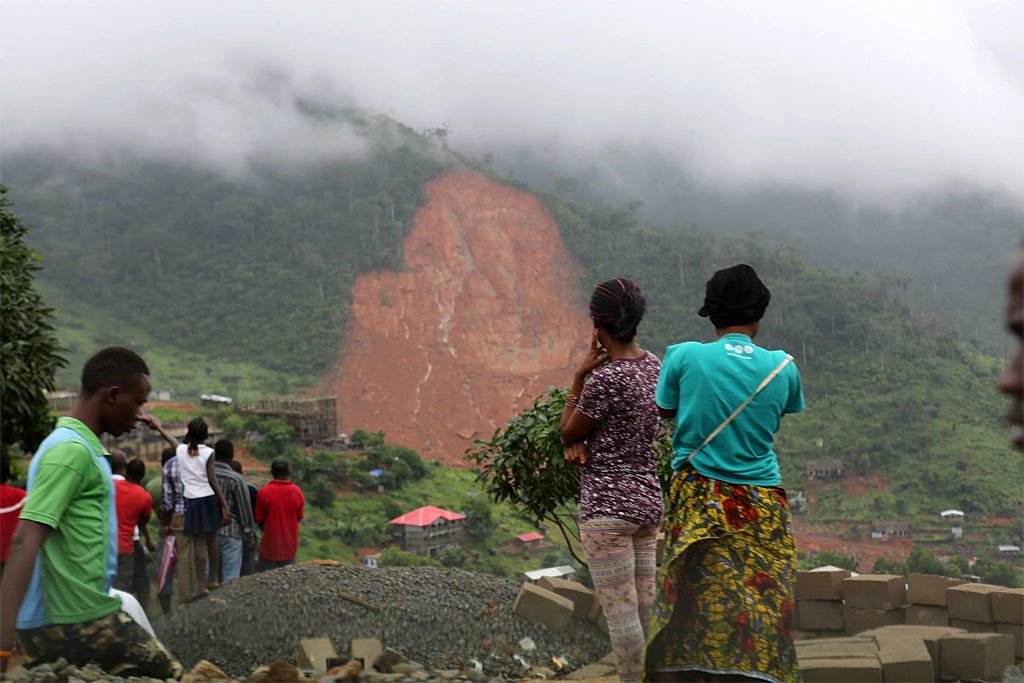Rainy season is currently upon Sierra Leone but this year the rains brought more than the country can handle.
Heavy rains over the weekend around the capitol Freetown resulted in flash flooding and several major mudslides, killing several hundred people and leaving thousands homeless. Many of the people most affected by this most recent disaster live in informal slum settlements that surround the city. The slums and this week’s flooding are a result of Sierra Leone’s tumultuous history and the poverty that still haunts the country, but may also offer the country a new opportunity to move the poorest Sierra Leoneans forward.
The small West African country is still trying to recover from the brutal civil war that ended fifteen years ago but destroyed much of the country’s infrastructure and gutted the educated class. Despite its tumultuous history, Sierra Leone is a stable democracy today but economic recovery has been harder to come by. After finally reaching double-digit GDP growth, the 2014 Ebola outbreak slashed employment rates and saw the economy contract by a full 21 percent. Although Sierra Leone is now back on the path of economic recovery, poverty continues to be the biggest issue affecting the country’s future.
Roughly 60 percent of the population lives below the national poverty level with subsistence agriculture and fishing being the main means of income for most of the country. The Ebola outbreak highlighted how precarious this setup is as travel restrictions and quarantines led to labor shortages, empty food stocks and heavily inflated prices for basic food items like rice. More than a year after the WHO declared the Ebola epidemic over in the country, food prices have not fully normalized. As usual, it is the poorest people who suffer the burden of these economic realities.
In urban areas, many of those people can be found in the informal settlements that dot the landscape. According to Slum Dwellers International, Sierra Leone has 111 informal settlements, mainly around the capital Freetown. Some of the slums date back to British colonial times, but most are the result of housing shortages in the 1970s and 80s, displacement from the civil war, and urban economic migration in more recent years. These are often vibrant communities close to transport hubs and urban jobs, but the informal status of the areas bring with it numerous risks.
Surrounding the old colonial central business district, the settlements stretch up the steep hillsides into the Western Area Forest Reserve south of the city and to the edge of the ocean on the other three sides of the peninsula. The mud huts and corrugated steel shelters are built illegally on state-owned land, often becoming severely overcrowded while not enjoying basic services like sewer systems. Without legal title to the land and under the constant threat of eviction, there is little incentive to upgrade the buildings but the makeshift shelters are highly vulnerable to extreme weather, especially during the summer rainy season.
The existence of the slums themselves add to this vulnerability.
The more buildings that go up on the hillsides and push back the forest, the more erosion becomes a major issue. Likewise, the coastal settlements make flash flooding more severe by limiting natural water absorption through human construction. Neither of these problems are unique to Freetown, or even developing countries in general. But year after year city officials seem unable to address the basic realities facing these communities in the rainy season.
August is the wettest month of the year in Freetown and floods are not uncommon, nor is death resulting from those floods. In 2015, then-unprecedented floods killed at least 12 people and left thousands homeless. However the scale of this week’s flooding took city officials by surprise. The city mortuaries are already beyond capacity as efforts to locate hundreds of people still missing are underway even while flood waters have yet to recede. People located in the slums have been advised to move to safer ground, but few have anywhere else to go. Instead, they wait for the rains to stop so they can start rebuilding, again.
That is, if they get the chance. Following the 2015 floods, the government set up new land tenures outside of Freetown to relocate those from the badly hit Kroo Bay settlement. For many, this forced relocation took them away from the community they knew and everything they had worked for including their businesses and jobs. Many ultimately returned and this year, faced flooding once again.
The scale of the destruction this year presents a new opportunity for the government to reevaluate how to engage with these communities. Relocation is, at best, a temporary measure. Experience says these communities are here to stay, but upgrades to building quality, drainage and basic public services is desperately needed, not just to avoid similar disasters in the future, but to also improve the overall well being of slum inhabitants. This is a huge investment for a country still recovering from civil war and Ebola, but one that will pay dividends long into the future.
